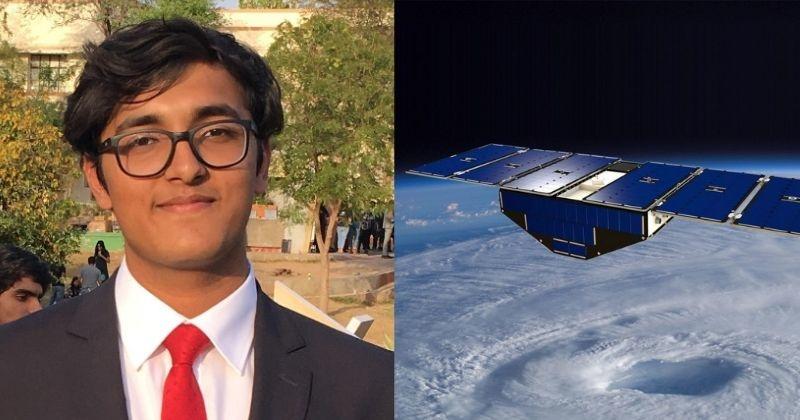Two Indian Men Will Launch Satellites To Help Improve Crops For Farmers
Dhir Acharya - Dec 16, 2019

The launch is scheduled for June 2020. The satellites are expected to provide useful information on crops so that farmers can take better of them.
- Delhi Is The World’s Most Polluted Capital City For Three Years In A Row
- Indian Farmers Install High-Tech, Night-Vision CCTV Cameras To Protect Themselves
- Looking For The Best Electric Bike In India 2021? Take A Look At These
Normally when talking about satellites, most of us think of major launches conducted by space agencies that cost hundreds of crores of rupees. We mostly think of satellites as giant machines that will send us data from outer space, which is true in many cases.
But there are also independent space agencies that design smaller satellites to do the same job.
In this case, 22-year-old Kshitij Khandelwal from PITS Pilani, along with Awais Ahmed – his classmate and colleague, India, will soon launch several satellites with the size of shoeboxes into space.

They have a company called Pixxel and are working on setting up the smartest observation satellite constellation in the world. the pair want to set up an array of satellites that capture high-quality images to achieve a better collection of data for various applications, which include air quality, weather, farming, and more.
Their team consists of former ISRO scientists who have worked on India’s first Moon mission Indus that will provide a lot of knowledge as well as experience to make sure the project succeeds.
The first satellite launch of this project is scheduled for June 2020, which will be sent into space on a Russian Soyuz rocket. So how did they create satellites and send them into space? What challenges did they face? As the process simple to difficult?
Bring the satellites into space through ridesharing
Talking about this matter, Kshitij said that launches work like buying tickets and travel to places on a bus. In particular, there are ride-share launches for independent agencies to launch smaller, inexpensive satellites. They book a ride-share launch with a launch provider and pay for the orbit they want to set their satellites in.
Assemble a satellite
Kshitij gave a cool analogy about the assembly of the satellites. He said the process is similar to building something out of Lego pieces except for the fact that it takes only one failing piece to fail the whole satellite.

The cost to launch a satellite into space
According to Kshitij, it’s cheaper to launch a microsatellite. Heavier satellites often cost more to launch, so they focused on micro ones. It takes tens of thousands of dollars for just one kilogram of the object to be sent into lower earth orbit.
He added that while space is expensive, India has an advantage in the field from how ISRO has functioned in all those years, from which they can build cheaper space infrastructure than in other countries.
How difficult it is to send a satellite to space
Launching rockets depends on the regulatory authorities in a specific country. Those who want to launch a rocket have to get the right clearances, licenses to build the rocket, get fuel, as well as launch the thing, he said.
He further said that India gives license for imaging and communication. Once one gets an imaging license, the country is internationally responsible for where a satellite can capture images or not.
The applications of Pixxel’s satellites
Kshitij shared that the satellites will capture data that will provide farmers with information on crop diseases, helping them identify crop species. In countries with mixed cropping patterns like India, it’s difficult to identify different crops. So the information from their satellite will let people access many platforms where they can see whether there’s a pest infestation, they can also predict the crop yield.
The cameras on the satellite
According to Kshitij, the cameras on the satellites aren’t very different from those on the smartphone with similar sensors. However, image processing on satellites have to be lower-power because they rely on solar panels.
Besides, satellites are larger than smartphones, use solar energy and require less power.
What’s next for Pixxel
Kshitij said that along with the launch in June 2020, the company is also working on a launch for December 2020 and one for March 2021. He added that they have already had things in mind to set up a satellite constellation. They have also thought of applications even before working on the satellites with targets in environment conservations, pollution monitoring, and agriculture.
He wanted to provide useful data for customers to make a difference.

Featured Stories

Features - Jul 01, 2025
What Are The Fastest Passenger Vehicles Ever Created?

Features - Jun 25, 2025
Japan Hydrogen Breakthrough: Scientists Crack the Clean Energy Code with...

ICT News - Jun 25, 2025
AI Intimidation Tactics: CEOs Turn Flawed Technology Into Employee Fear Machine

Review - Jun 25, 2025
Windows 11 Problems: Is Microsoft's "Best" OS Actually Getting Worse?

Features - Jun 22, 2025
Telegram Founder Pavel Durov Plans to Split $14 Billion Fortune Among 106 Children

ICT News - Jun 22, 2025
Neuralink Telepathy Chip Enables Quadriplegic Rob Greiner to Control Games with...

Features - Jun 21, 2025
This Over $100 Bottle Has Nothing But Fresh Air Inside

Features - Jun 18, 2025
Best Mobile VPN Apps for Gaming 2025: Complete Guide

Features - Jun 18, 2025
A Math Formula Tells Us How Long Everything Will Live

Features - Jun 16, 2025
Comments
Sort by Newest | Popular